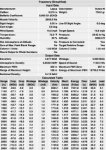I think both accounts are pretty far fetched when you start doing the math and looking at the equipment limitations. I saw a good write up on the Aussie 2815 meter shot that pretty much proves that it was next to impossible to do. If I can find it, I'll post it up as it goes into great detail on the "why" it can't be an accurate distance or account of the shot.
Found it, here is the link:
Steve Reichert on the 2815 Meter Shot - Soldier Systems
Steve Reichert on the 2815 Meter Shot
Former Marine Sniper Steve Reichert posted his take on the recent claims that two Australian Snipers made a 2815 meter shot within seconds of each other on his Facebook wall. He isn’t saying it was impossible, but rather letting the science speak.
I recently came across a news article stating that two Australian Defense Force snipers had killed a Taliban “commander” at a distance of 2815 meters. They were using a Barrett M82A1. I thought the story was a little fishy; after all trying to get positive ID on a person at said distance is extremely hard with conventional optical devices. The question stuck in my mind… was the shot even possible? Let’s look at the math involved, after all physics don’t lie.
•Rifle: M82A1
•Ammunition: Unknown, let’s give them the benefit of the doubt and use a plug in a match grade 750 grain Lapua @ say 2700fps
•Scope: Unknown, let’s give them the benefit of the doubt and use a S&B 5-25×56 PM II/LP/MTC/LT
•Scope base: Unknown, let’s give them the advantage and use a base with 30 MOA built in
•Zero Distance: Let’s give them the benefit of the doubt and use 900 meters
•Altitude: Let’s give them the benefit of the doubt and use 5000ft MSL
If the rifle didn’t have a 30 MOA base, and was zeroed at 100m like most sniper rifles are, then you would need a total come-up of 67.85 mils (233.25 MOA). That’s a lot of mils, and most scopes do not have half that adjustment range. Suppose that they did have a 30 MOA base on the rifle… and they were only interested in making an extremely long shot, so they zeroed at 900 meters. Doing this would drop the total come-up’s required to hit at 2815m by a little over 7 mils, to 60.29 mils (207.26 MOA). Now subtract the 30 MOA ramp angle and you get the actual remaining, real scope come-up of 51.56 mils (177.26 MOA). This is still outside the available travel of most scopes. The S&B 5-25×56 lists only 26 mils of total elevation travel, so it would most likely be impossible to dial on enough elevation to make a shot at 2815m. This would mean they would have to hold…. But in order to see the target they would have to power the scope down. The FOV specification for the S&B is 5.3 meters at 100 meters with the scope at minimum magnification and 1.5 meters at 100 meters with it at maximum magnification. Field of view is all the way across the scope, so the maximum hold you can accomplish optically; going all the way from center to the rim is half of these values. So, at minimum magnification we can hold up to 0.5 x 5.3 / 100 = 0.0265 radian or 26.5 mils all the way to the rim. At maximum magnification this is 0.5 x 1.5 / 100 = 0.0075 radian or 7.5 mils. As stated earlier, since the scope has a maximum vertical adjustment of 26 mils and the shot requires a total of 67.85 mils, the optical hold required would be 41.85 mils. Even at minimum magnification, the available field of view would only allow about 63 percent of the required hold. At maximum magnification, it would only allow about 18 percent of the required angle.
Bottom line: Using the gear they more than likely had, and assuming they had smoking hot match grade rounds, the best optics and ramped scope bases… it’s highly unlikely this shot was pulled off…
Special thanks to Dr Lyman R. Hazelton at Empyreal Sciences for his contribution to this article.
Semper Fi
Steve


